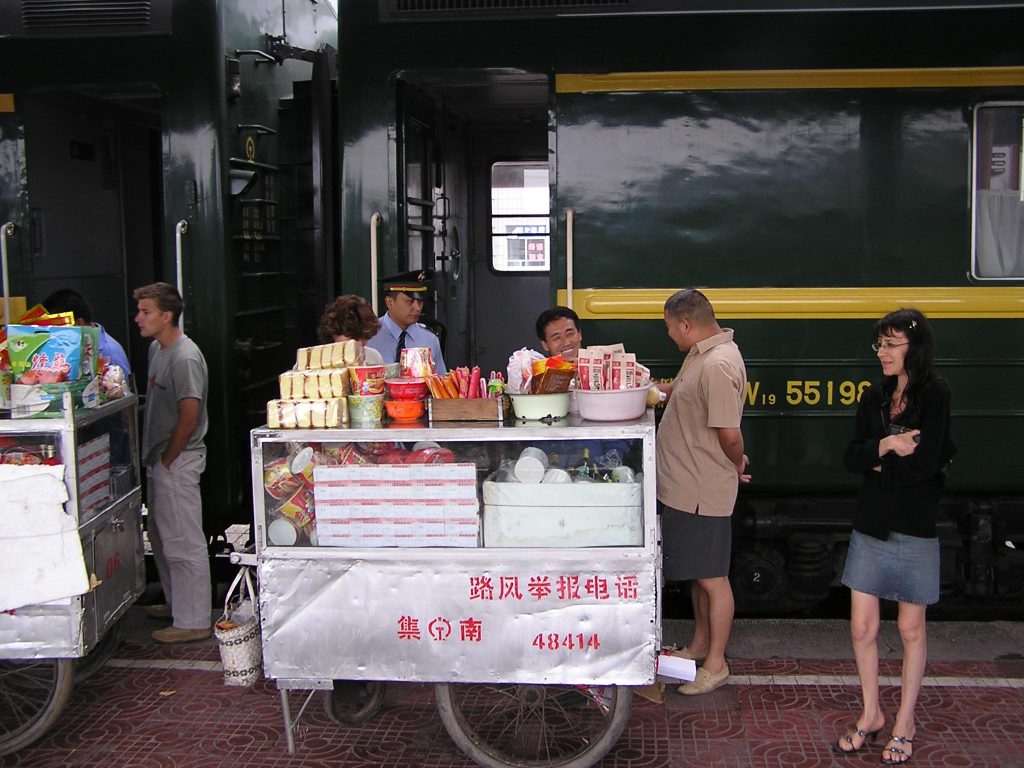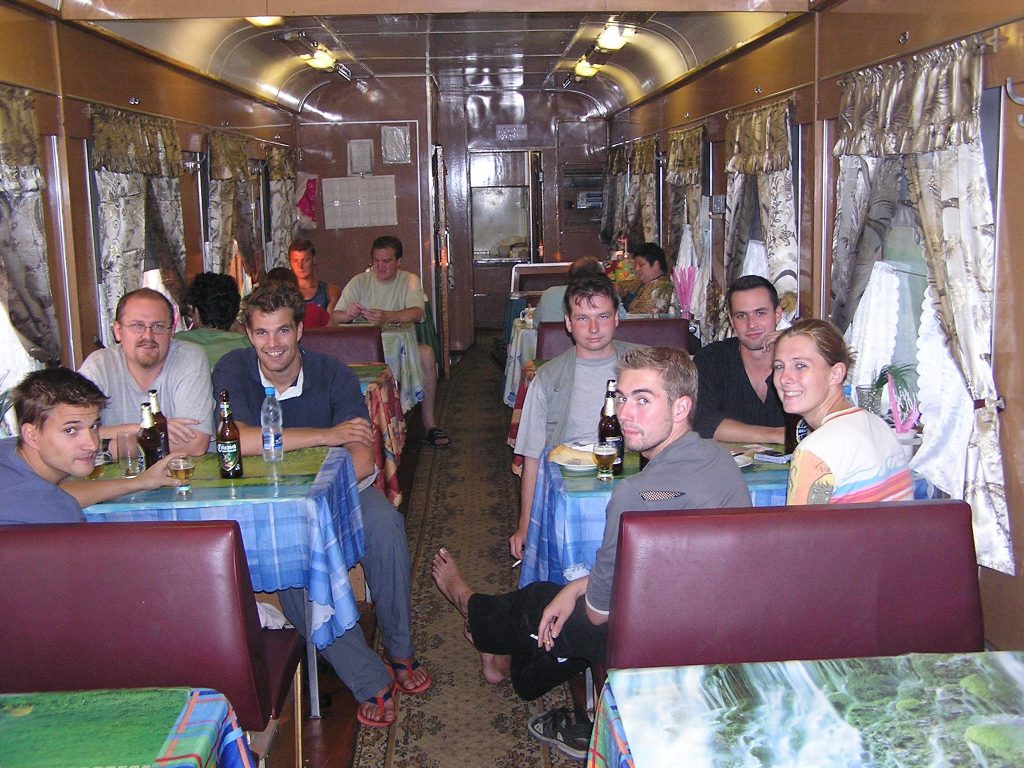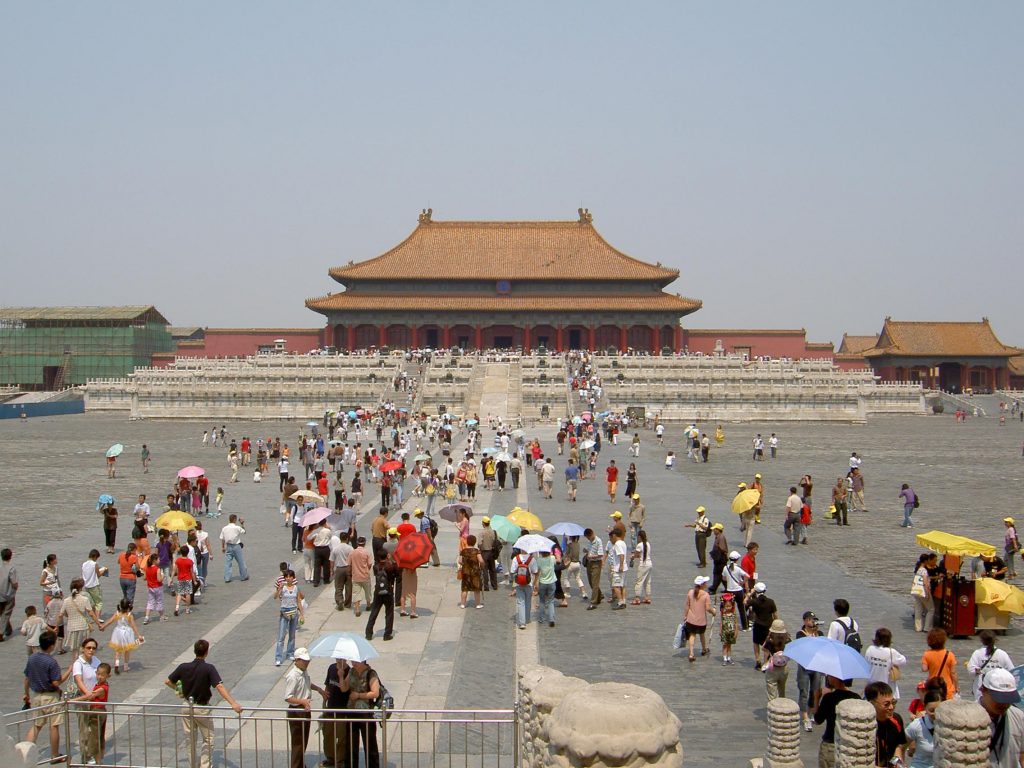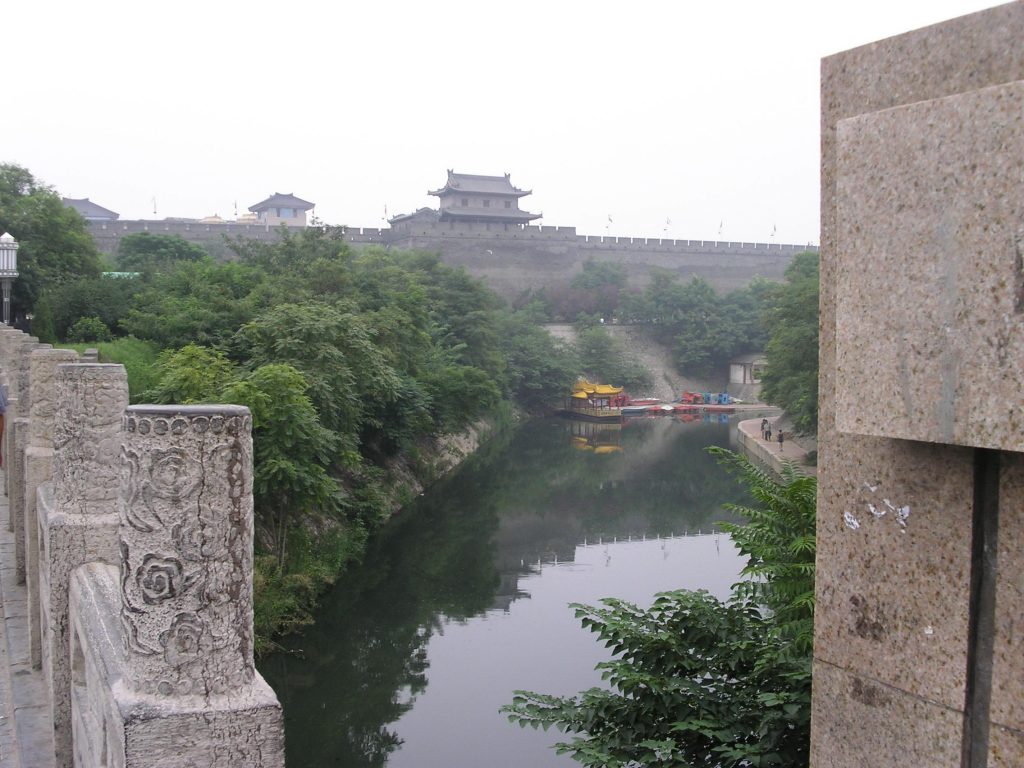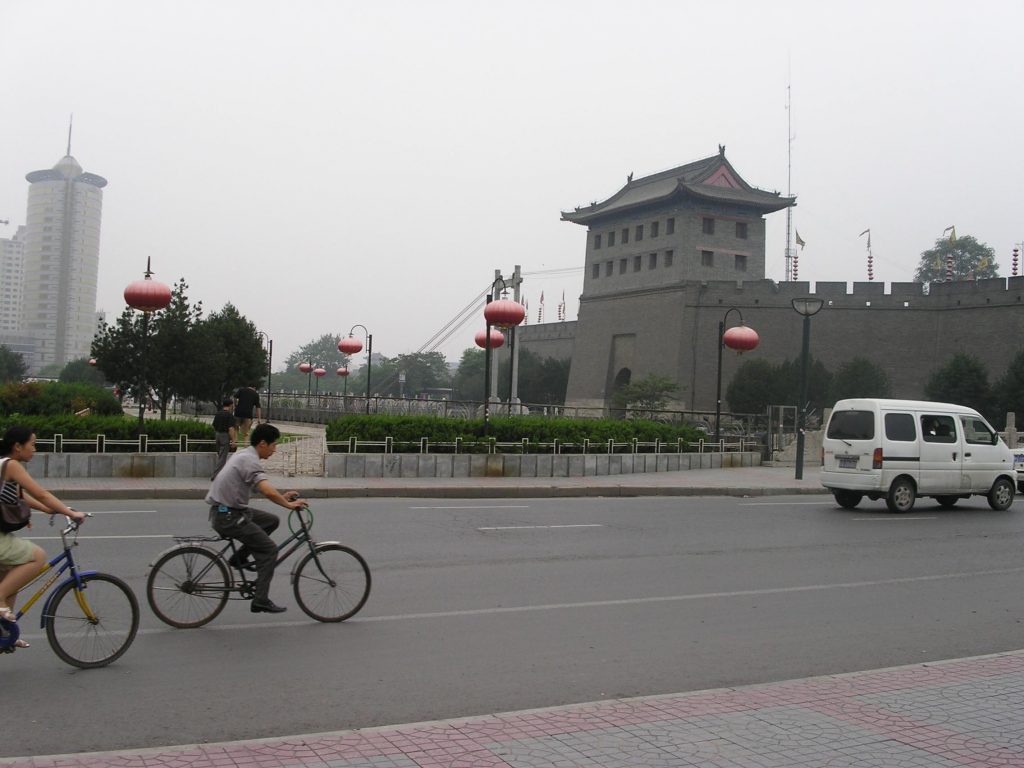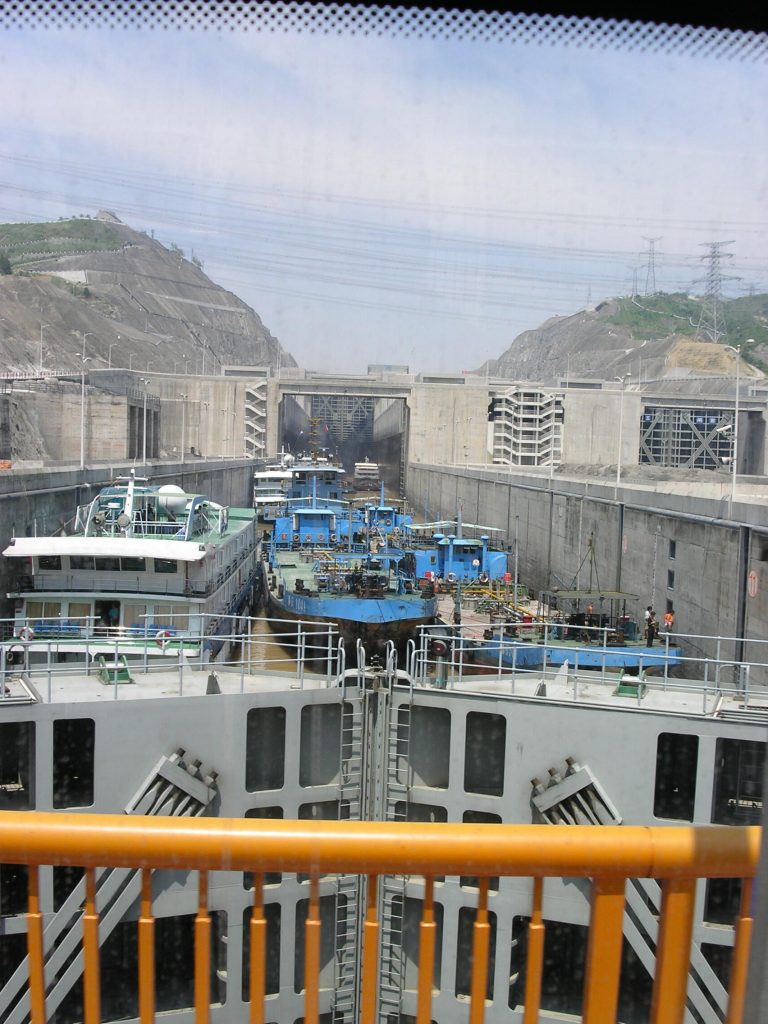Day -1 Tues Aug 10th
My first job today was to pick up dad from the airport. I was looking forward to seeing him after almost 11 months. The flight was on time and surprising quickly he emerged from immigration. A big hug and it was off to find a taxi back to the hotel. That was easy enough but despite having a card with the address in Chinese, a map and a photo of the hotel the taxi driver headed to the wrong place. Beijing traffic is not the place where you want to go further through the centre than you need to, especially after a long flight.
After dad had a quick shower and change it was off for a quick lunch in a food mall in the basement of Oriental Plaza. Most of the food outlets here are as you would expect almost anywhere else, but Megabite is a room surrounded by food stalls cooking local food as you order it. I headed for bowls of pork dumplings in sour soup. Beijing was pretty humid that day, Megabite even more so therefore we were pretty sweaty fairly easily. The other task of the day was to buy some food supplies for the train journey as I’d been recommended to in the Lonely Planet and on the web in case the restaurant car was dreadful. This turned out to be juice to mix with dad’s duty free vodka, loads of tins of tuna and a few packs of muesli bars. I had in previous days already bought a case of red wine, a case of beer, a stack of loo rolls and a luggage trolley to carry it all, plus dad had brought with him coffee, tea, sugar and coffee mate. We were sorted.
Whilst dad headed for a wee mid afternoon snooze to kill some of the jet lag, I headed to the Military Museum. The ground floor was dominated by a large collection of tanks, planes, rockets and artillery pieces, all of which are Chinese copies of Russian 2nd line equipment from when the two countries were friendly. Exhibitions upstairs cover particular conflicts and are a source of amusement. Little of what’s in the Korean conflict room is translated but what is blames American imperial aggression; omitting neatly the fact that it was the UN supporting South Korea and had far more international support than the recent conflict in Iraq. Also of interest is the room covering World War II, far more here was translated into English, which provided greater opportunity to see the scale of omission. Admittedly the Chinese had been invaded by the Japanese in 1932 and had fought a resistance campaign since, but it doesn’t excuse the only mention of any other nation fighting being a few sentences referring to anti-fascist forces. Nothing said of the minor part the Americans had in defeating Japan or the atomic bomb, its like the French covering WWII without mentioning D-day; inconceivable.

That night we headed for a meal of Beijing duck. The original restaurant I selected had a large queue outside and whilst waiting we were approached by a girl offering to take us to another under the same ownership nearby. We were sceptical but there was little to be lost by following her and taking a look. We arrived at a typical Chinese restaurant, all plain walls, tiled floor, plain white tables (the décor you’d select to extract the entire atmosphere from a place) and filled with locals. The number of locals swayed us and we stayed for an excellent meal of duck carved at the table and washed down by local beers.
With an early start tomorrow it was early to bed.
Day 0 Wed 11th Aug
The train departed at 07:40 in the morning and knowing the chaos of your typical Chinese station we aimed to be there an hour in advance. Things went smoothly enough except emerging from the hotel to find for the 1st time that there were absolutely no taxis waiting and having to flag one down. It was fairly smooth going after that with us being allowed onto the platform, and therefore our cabin, about half an hour before departure. The cabin itself looked comfortable enough with two beds, one above the other on one side and on the other was the shower shared with the neighbouring cabin and a chair by the window. Home for the next 5 to 6 days.
With time remaining before departure I headed to a nearby stall to buy more bottled water, some fruit and a couple of pot noodles. Dad and I then took turns to nip up and down the platform taking pictures of the train prior to departure. At 07:40 on the dot we set off on one of the longest train journeys in the world. Being a bit early for a beer we celebrated with a cup of tea, hot water being available from a boiler at the end of the carriage.
After leaving Beijing it’s not long before the train starts to ascend through the mountains via a series of very long climbs and tunnels. The landscape is spectacular and is enhanced by passing close to the Great Wall at a couple of points. Unfortunately the weather is overcast and it saps the colour from the scene. The sights are still great by eye but photos look bland and washed out. It’s not long before it’s time for a pre-lunch aperitif and then we head to the restaurant car clutching the first of our stash of wine. At this point it’s a Chinese run restaurant car coupled only one carriage away from our own. There is no choice, you’re just fed the set menu but it was tasty enough and we managed to get a couple of paper cups for the wine from the staff. I thought I was being a messy drinker until I realise both cups had small leaks.
It’s here that we get to know our fellow rail passengers, all of whom in the restaurant are westerners. The largest faction is a group of Americans on an organised tour and shepherded by the tour leader who tells them where to be and when. Its feeling good to be independent. The afternoon passes quickly enough, watching the landscape change out the window, me reading magazines and dad having a snooze. Before long it’s time for dinner. The restaurant car is busy with the Americans having all arrived en-mass and we end up sharing our table with a couple of European journalists we’d met at lunch. Dad and I are clutching another of our wine collection, but the journalists have to order one of the restaurant’s supply. It’s a red wine and turns out to be sweet. We share ours with them and then after dinner I get out a good Chinese red I’d bought to show them that not all Chinese wines are that bad. Before long our vodka and their brandy has come out.
It means we’re all fairly lubricated by the time we arrive at the Chinese – Mongolian border at around 10ish that night. First of all we stop at the Chinese border post where there is an option to get out and stay in the station whilst the formalities take place. Whilst the Chinese officials go about their business the train is shunted into a shed where the wheels are replaced with those of the correct width for Russian spec railway lines. We have been advised to stay on the train so we can observe this operation taking place, however we find that when in the equipment shed we are locked in the train and can’t see what’s going on very well. Given the amount I had drunk this was probably just as well.
After the wheels are changed we are shunted back to the Chinese border station, pick up the few that had got off the train, our passports were returned and we rolled towards Mongolia. Several people decided the excitement was over and were going to head to bed until I pointed out with weary experience that we had only just been stamped out of China. We still had Mongolian border officials to deal with. Country entry cards and customs declarations can be awkward enough documents at the best of times and even more so late at night after an evenings drinking but we get through it OK and several hours after arriving at the border we entered Mongolia and were able to head to bed.
Day 1 Thurs 12th Aug
After a surprising good nights sleep (I had been so unsuccessful on previous “sleeper trains” that I had decided the description was an oxymoron) we awoke to a glorious day as the train rolled through the Mongolian steppe. It’s fairly flat in every direction meaning you can see for miles and what you see is an empty wilderness, untouched by man and containing only sparse grass. Every now and then will be a small village containing a mixture of wooden huts and the more tradition yurts. Around these will be small scattered herds of cows, sheep or goats sometimes herded by “cowboys” riding horses. I have a small pang of regret that we’re staying on the train and won’t get a chance to explore this area more closely.
The morning passes fairly quickly watching this incredible landscape pass by. It’s unchanging and empty and should be boring but something about its size and emptiness is enthralling, possibly aided by the light cast by the clear skies. We are due to arrive in Ulaan Baator early afternoon so there’s a chance for a last lunch with our new journalist friends. Marion and Gundi are spending 10 days in Mongolia producing a documentary for the TV which will include an interview with a senior UN official. They are concerned about getting off the train OK, as they have a fair amount of equipment and Gundi wants to get filming quickly as she wants shots of other passengers disembarking. Dad & I volunteer as roadies, myself in the condition that the camera is pointed nowhere near me. We arrive at the station on time and all goes smoothly. As we have around a half hour stop here I have the chance to wander out to the front of the station. The city looks fairly small and is certainly low rise. It’s probably the 2nd smallest capital city I’ve been to after Apia, Samoa. A final series of goodbyes and swapping of email addresses and we’re off again. Dad’s slightly depressed that we’ve lost the best friends we’d made so quickly, whilst I’m more used to this by now.
Late in the day the landscape starts changing as we head into a more mountainous region on the border with Russia. Its here I spot a couple of fairly sorry looking fields and realise something that had been entirely missing from the Mongolian vista: no agriculture ???? horticulture! We had crossed through most of Mongolia from south to north including its 2 largest cities and passing by many villages without seeing a single plant being grown. Not a single flower bed, vegetable patch or arable field. It must be based on the Mongolians nomadic heritage that they rely solely on animal husbandry even though most of the settlements we’d seen looked fairly permanent. They still haven’t developed green fingers.
Our companions for dinner that evening are a couple of the Americans, Kathy & Marilyn. Kathy has an energetic personality and organises a lot of holidays for her group of friends. It’s another fun meal of shared stories and experiences, the atmosphere aided by the fabulous embellishment of the dining car. The restaurant had been changed at the border and the Mongolian car was decorated with an incredible display of carved wood.

Again around 10ish at night we arrive at a border, this time the Mongolian-Russian one. The Mongolians aren’t in a rush to let us out, but it’s nothing to the time taken by the Russians to sign us in. They also search everywhere, under the beds, in the luggage racks, even shining a torch through the air-conditioning vents. It reflects the trials of getting a Russian visa; their entry/exit system is still that of the cold war. We fall asleep before all the formalities have finished, before even our passports are returned and 7 hours after arriving at the border we start our journey through Russia and are allowed the remainder of our sleep undisturbed.
Day 2 Fri 13th Aug
I’m awake before Dad and head into the corridor to make a cup of tea, stare at the landscape and to try and work out from the mileposts and the Lonely Planet where we are. When Dad awakes he heads to the restaurant for breakfast, but as I’m not a great fan of eggs I have decided that my breakfast will be based on the supplies we brought to the train. For the next few days this will become our routine for the early mornings. Dad returns with the news that the restaurant is now at the back of the train about 5 carriages away. This is a pain as it means passing through over 20 doors to get there. Again the landscape is different with trees covering the landscape, though we had seen the start of these in the Mongolian mountains near the border. The towns also look more permanent, though the streets are normally mud but the big difference is the allotments which use up much of the space cleared of trees. Closer inspection reveals that many of these plots are now abandoned and I theorised that in the days of communist shortages and in Russia’s transition to capitalism these might have been a key source of fresh food, but these days are less necessary. Maybe it’s just population movement away from these more remote areas of Mother Russia.

The scenic highlight of the day is rounding the south end on Lake Baikal. It doesn’t appear until early afternoon, a couple of hours later than expected and probably due to the time taken at the border. It is a vast body of water 636km from north to south, at 1637m the deepest in the world and it contains one fifth of the world’s fresh water – more than Americas 5 great lakes combined. It also very scenic, largely undisturbed apart from the railway carving through the rocks of the south shore. For the first few years of operation the trains of the trans-Siberian railway had to be shipped across the lake by boat, sometime being delayed by weeks as the lake froze over in winter. The final section here was one of the most challenging of the railways construction requiring 33 tunnels and a 100 bridges & viaducts, eventually opened in 1904 linking Russia’s east and west coasts. It also means we are travelling on what could be considered the railway’s centenary year.

We role into Irkutsk mid afternoon where the American posse, including Kathy and Marilyn, are leaving the train. The departure empties the carriage next to us and again we are swapping emails and promising to stay in touch. My goodbyes are brief as I am on a mission to get some useful money. At every border I have passed through until this train trip there has been someone more than willing to change your money. I had therefore arrived on the train with a big bundle of Chinese Yuan that I now need to turn into rubles. My miscalculation is that at both borders we have been stuck on the train and therefore unable to check out the exchange options. Here in Russia’s first major station I am hoping for an exchange desk or an ATM, however our carriage attendant claims we are only stopping for 15 minutes. It’s a reasonable run through the tunnels to get to the main station building and nothing there looks hopeful. I eventually find a desk that might be useful but am told to clear off by a guy in uniform wearing a gun. Time is ticking and there is nothing to stop the train departing without me so I head back. Eventually the train leaves around 30 minutes after we had stopped and I still have no useable cash. Fortunately Dad has brought a load of American dollars that the dining car accepts but its shaken me that after 10 months of travelling I’ve managed to make such an elementary mistake.
Day 3 & 4, Sat & Sun, 14th & 15th Aug
For the next couple of days we fall into a pleasant routine. I wake up first, grab a cup of tea and hang out in the corridor working out where we are, checking out the landscape and chatting with the neighbours. Dad wakes, has a cup of tea and heads off to the dining car for breakfast whilst I have something in the cabin. The rest of the morning is generally spent observing the scenery pass buy, reading up on the local area and discussing between us. It was clear how important this railway was as it was tremendously busy, largely with freight trains and was obviously a lifeline to these remote parts of Russia. However it was also clear it wasn’t enough as virtually all industry here looks neglected or totally derelict. The switch to capitalism has obviously hit hard out here.
Occasionally we get the treat of arriving at a station which gives us the chance to get off the train and stretch our legs. I had hoped to do some bargaining with traders for local goods such a smoked fish, vodka and Russian champagne; only two snags that apart from a couple of stations in the far east there were no traders and I had no useful money.
Lunch saw us heading for the restaurant car which was now the Russian one since the border. The person running it was a stereotypical local lady to look at including having gold front teeth but whereas we had been warned about surly service she was extremely friendly. Also part of the crew was a very fit guy in his mid 20’s who didn’t seem to do anything, a lady who cooked, another young guy and an older guy. It was a strange setup with only 2 of them (OK 3 at most) actually ever doing anything. I favourite items on the menu were soup and beef in pot, both of which started out extremely tasty with lots of delicate meaty bits and both of which by the ends were a bit less tasty and using the scrag ends of the meat.
The clientele of the dining car was the few westerners on the train, the Chinese passengers sticking with stuff they made themselves in their cabins (primarily pot noodles). The afternoons & evenings were spent playing cards with our fellow westerners, primarily two card games which any traveller will be familiar, Arsehole and Shithead. The other regular players were: Tom returning to the UK to take up a career in law having spent the last 3 years clearing mines in South East Asia and Africa, Dan & Fleur from Amsterdam, a Spanish/Italian couple and English lad Will. Irregulars included 3 Brits and 3 Aussies who had joined the train in Irkutsk and resided in a carriage added behind the restaurant car. Also part of our social scene back in our carriage was a Russian guy on one side and an extremely slim French lady sharing a cabin with Tom on the other. Throw a few beers into the mix and it was an extremely pleasant way to pass the time and kilometres.
Day 5 Mon 16th Aug
The night before Dad & I brought our remaining beers down to the restaurant, dishing them out to the staff and our friends. It seemed strange that the journey was almost over. In preparation for the trip I had asked Dad to get a travel chess/draughts/backgammon set and to bring a few good books. I had also bought a couple of books in Beijing for the journey. In the end the books never got read and the games set never opened.
The first part of the day passed in a similar way to those before including lunch back in the dining car, the only exception being the young Russian who was totally pissed having started drinking vodka at breakfast. Eventually the train got to the outskirts of Moscow and then before long we had arrived bang on time five & a half days and 7865km after we started. Strange to be back in Europe after over 11 months.








